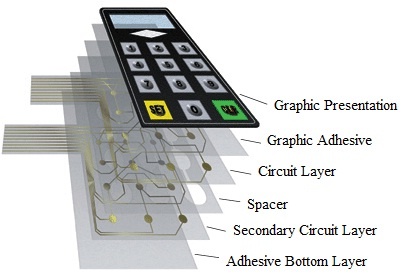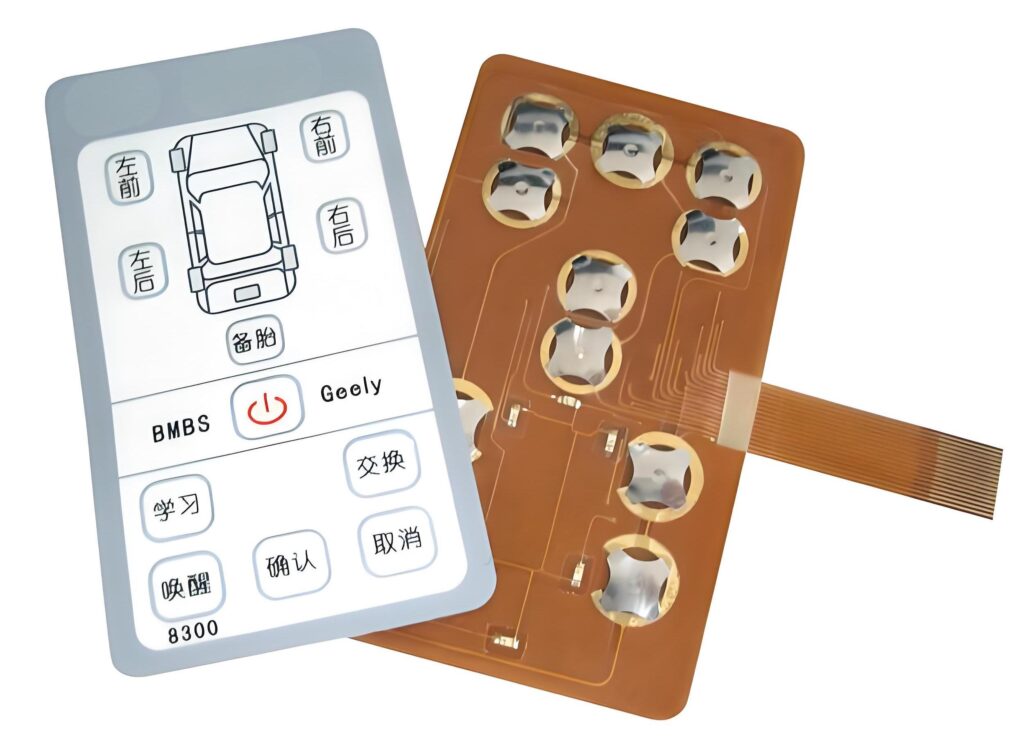The Production Process Behind Membrane Layer Switch: What You Required to Know
The manufacturing procedure behind membrane changes combines careful style, product choice, and top quality control. It begins with recognizing the complexities of membrane layer switch layout and progresses with numerous stages, consisting of material options and printing strategies. Each phase plays a crucial role in making sure functionality and toughness. However, the complexities of layer building and construction and the rigorous testing criteria might reveal understandings that are not quickly noticeable. What lies past these fundamental components?
Understanding Membrane Change Layout
Membrane layer buttons may appear simple at first glance, their style includes elaborate factors to consider that ensure performance and longevity. The layout procedure starts with a complete understanding of user needs, consisting of the user interface's desired application and ecological aspects. Comfort designs is a vital component, as the format needs to assist in simplicity of use while guaranteeing that tactile feedback fulfills customer expectations.Moreover, the layering of elements, such as graphic overlays, adhesive layers, and conductive traces, must be specifically crafted. membrane switch. This layered configuration not just affects the switch's responsiveness but also influences its durability. Attention is offered to the securing methods utilized to protect versus wetness and dust, which can jeopardize performance. In addition, style considerations include aesthetics, where shade plans and aesthetic clearness enhance customer experience. Eventually, the design of membrane layer changes equilibriums performance, user experience, and longevity, making sure that they meet the needs of various applications properly
Materials Made Use Of in Membrane Switch Over Manufacturing
When picking materials for membrane layer switch production, it is important to ponder both performance and longevity. The main products include polyester and polycarbonate movies, which provide adaptability and strength. These films are often covered with glue to ensure correct bonding to substratums. Conductive inks, typically made up of silver or carbon, are critical for producing electric connections within the switch, permitting dependable operation.Additionally, a safety layer, such as a tough coat, is often used to boost scratch resistance and durability. The option of backing product, such as acrylic or foam, can considerably affect the button's responsive feel and general individual experience. Different ecological variables, consisting of temperature level and humidity, should direct material option to guarantee peak performance in particular applications. Eventually, the ideal mix of products adds to the membrane layer button's performance and life-span, making educated selections crucial for manufacturers.
The Printing Process: Creating Graphics and Text
The printing procedure in membrane layer button production plays a substantial duty in creating top notch graphics and message. Different graphic style techniques are employed to guarantee aesthetic allure and capability, while mindful ink choice techniques are vital for sturdiness and performance. Understanding these elements is basic for accomplishing finest results in membrane button style.
Graphic Style Techniques
Graphic design strategies play a crucial function in the printing process of membrane layer switches, as they specify exactly how graphics and message will eventually appear on the last product. Reliable graphic layout includes the strategic usage of layouts, shades, and fonts to boost readability and visual allure. Designers commonly utilize vector graphics for scalability, making sure that images stay sharp at numerous sizes. In addition, attention to contrast and placement is vital, as it affects customer communication and visual high quality. The unification of branding elements, such as logo designs, have to be handled with treatment to keep brand stability. On the whole, thoughtful graphic design methods add considerably to the functionality and appearance of membrane layer switches, impacting individual experience and item efficiency.
Ink Option Methods
Choosing the proper ink is crucial for achieving the desired visual high quality and longevity in membrane switch production. Numerous ink types are utilized, including solvent-based, water-based, and UV-curable inks. Each type provides unique attributes, such as adaptability, resistance, and bond to ecological aspects. Solvent-based inks are usually favored for their resilience and dynamic colors, while water-based inks are much more eco-friendly but may have constraints in attachment. UV-curable inks give quick treating and robust performance. Additionally, shade matching strategies ensure that the chosen inks align with layout requirements. Eventually, the option of ink should consider variables such as application approach, substrate compatibility, and end-use requirements to attain premium lead to membrane button graphics and message.
Layer Building and Assembly

Product Option Refine
A mindful selection of materials is important in the manufacturing process of membrane layer buttons, as it straight affects capability and longevity. The primary products made use of consist of polyester, polycarbonate, and numerous conductive inks. Polyester is often favored for its excellent resistance to chemicals and abrasion, making it suitable for harsh environments. Polycarbonate, on the various other hand, gives premium quality and influence resistance, which is helpful for applications needing presence and effectiveness. Conductive inks, commonly made up of silver or carbon, are crucial for producing reputable electrical pathways. In addition, the selection of sticky materials impacts the total stability of the switch - membrane switch. Evaluating variables such as ecological exposure, tactile responses, and aesthetic requirements overviews makers in choosing the best products for their certain applications
Layer Adhesion Strategies
Sticking layers in membrane button building is a vital procedure that guarantees capability and durability. Various attachment techniques are used to protect ideal bonding in between layers, which usually consist of the usage of adhesives, heat, and stress. Pressure-sensitive adhesives (PSAs) are commonly made use of for their ease of application and prompt bonding abilities. Furthermore, thermal bonding methods can be used, where warm is used to trigger adhesive properties, protecting a strong bond. The option of attachment method mainly depends on the products entailed and the particular application needs of the membrane switch. Correct alignment and uniform application of adhesives are crucial to avoid issues, securing the switch runs effectively throughout its intended life expectancy.
Quality Assurance Steps
Ensuring top quality control during the layer building and setting up of membrane layer buttons is go right here important for preserving efficiency and integrity. This process usually includes numerous critical steps, including complete examinations at each phase of manufacturing. Manufacturers utilize sophisticated testing techniques, such as peel tests and bond evaluations, to confirm the honesty of layer bonds. In addition, aesthetic examinations are performed to recognize any kind of issues in printing or product incongruities. Ecological problems, such as temperature level and moisture, are very carefully kept an eye on to ensure suitable treating and bond. Moreover, normal calibration of tools aids preserve exact manufacturing standards. By applying these quality assurance procedures, makers can significantly reduce the threat of item failure, guaranteeing that the last membrane switches fulfill the needed specs and customer assumptions.
Evaluating and Quality Assurance Actions

Technologies in Membrane Switch Modern Technology
As developments in technology proceed to develop, membrane layer buttons are gaining from cutting-edge developments that boost their performance and user experience. One significant development is the assimilation of capacitive touch innovation, which permits for more instinctive and responsive customer interfaces. This shift not just improves aesthetics however also minimizes mechanical damage, prolonging the life-span of the switches.Additionally, developments in visuals overlay materials have brought about improved toughness and resistance to environmental aspects such as dampness and UV light. These materials now supply enhanced clearness and illumination, further elevating the aesthetic appeal.Furthermore, the unification of smart innovation is changing membrane layer switches into interactive control board, making it possible for connectivity with IoT devices. This connectivity cultivates a smooth user experience, leading the way for applications in different sectors, from healthcare to consumer electronics. Collectively, these advancements placement membrane layer switches as crucial elements in contemporary gadget layout.
Regularly Asked Inquiries
How Long Does the Membrane Switch Manufacturing Process Take?
The duration of the membrane switch manufacturing process can vary considerably. Factors such as complexity, materials used, and production volume impact timelines, with typical manufacturing varying from a couple of days to numerous weeks for conclusion.
What Are the Typical Applications for Membrane Layer Switches?
Membrane switches are commonly utilized in various sectors, consisting of auto controls, house home appliances, clinical gadgets, and consumer electronics (membrane switch). Their convenience and longevity make them ideal for applications calling for straightforward user interfaces and trustworthy performance in diverse environments
Can Membrane Layer Changes Be Personalized for Specific Needs?

What Is the Life expectancy of a Normal Membrane Layer Switch Over?
The lifespan of a typical membrane switch varies, but typically, it ranges from 1 to 5 million cycles. Elements such as usage, atmosphere, and material high quality considerably affect toughness and total efficiency gradually.

Are Membrane Layer Switches Over Eco-friendly?
The environmental kindness of membrane layer changes varies. Some products made see this site use of may not be recyclable, while others can be environmentally friendly. The overall influence relies on producing practices and products, requiring mindful factor to consider throughout option and disposal. The manufacturing process behind membrane switches combines mindful style, material option, and high quality control. It starts with comprehending the complexities of membrane layer button design and proceeds with numerous phases, including product options and printing methods. When selecting products for membrane button manufacturing, it is necessary to contemplate both efficiency and sturdiness. A careful choice of materials is necessary in the manufacturing procedure of membrane switches, as it straight influences capability and resilience. The selection of adhesion approach largely depends on the products entailed and the particular application needs of the membrane switch.